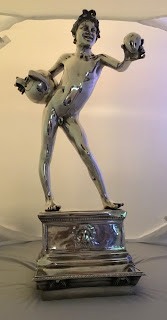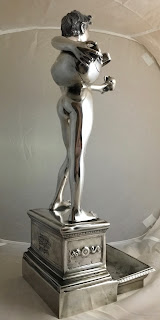Several days ago I was stumbling around on the eBay UK Auction site when I found a nice copy of Vencenzo Gemito's bronze titled L'Acquaiolo (The Water Vendor). What really caught my attention and curiosity was the fact that the bronze had detachable shorts to hide the normally exposed manhood of the brazenly naked little Neapolitan street urchin and something else, to my eye, was suspicious about the surface of that "bronze." There are so many variations of this bronze, clothed and unclothed, with a great variety of finishes, that it just boggles the mind but this is the first "convertible" edition of that nude lad I think I have ever seen. The next time Great Aunt Matilda comes over for a visit, and, who is deathly afraid of any representation of the male member because after eighty years she remains a virgin, then just slip on those pants and avoid a costly trip to the local Emergency room where "fainting couches" are few and far between! A very kind antiques dealer in London very graciously offered a considerable discount from the listed price and I executed the purchase. Here is the little street urchin in question:











Title: L'Aquaiolo
Artist: Vincenzo Gemito (1852-1929)
Foundry Mark: Fonderia Gemito Napoli
Materials: Silver over Bronze
Dated: circa 1911? (Although reference sources indicate this bronze, stamped with the "Gemito Bronze Foundry, Napoli" Stamp, was produced in the Gemito Foundry up to 1886.
-------------------------------------------
The website Tutt'Art has a nice concise biography of the artist:
"Vincenzo Gemito, born in Naples in 1852, is considered to be the most important Italian sculptor of the late nineteenth century and is increasingly regarded as one of its greatest draughtsmen. His origins were unpromising. An orphan street child until he was adopted by a poor artisan, he was put out as an assistant to the sculptor Emanuele Caggiano at the age of nine. He then attached himself informally to the older but more progressive sculptor Stanislao Lista, who apparently encouraged him to work from street models. Having acquired the skills of modeling in clay and wax, the young man set himself up independently. In 1868 he exhibited a sculpture at the Promotrice di Belle Arti in Naples, The Card Player, that showed a Neapolitan urchin scratching his head and studying a hand of cards. The work had the single good fortune to attract the attention of Victor Emmanuel II, king of Italy, who purchased a bronze cast of it for the Capodimonte collection, a notable honor for the sixteen-year-old sculptor. Gemito cultivated a kind of rugged realism in the interpretations of his subjects, conveyed by contrasting rough and smooth surfaces. His drawing oeuvre kept pace with his sculpture, and what has appropriately been termed his "naturalistic bizarrerie" as seen in 1876 in the terra-cotta Chinese Acrobat and also in a series of pen-and-ink studies of fisher boys, which culminated in the life-size bronze Little Fisher Boy (Museo Nazionale del Bargello, Florence). From 1877-1881 Gemito lived in Paris, where he was a friend of the sculptor Ernest Meissonnier, whose work could not have been more different from his own. On his return to Naples he incorporated another thread of tradition into his work, that of his classical predecessors in Pompeii and Herculaneum, which resulted in the bronze sculpture "Water Carrier" (Galleria Nazionale d'Arte Moderna, Rome). In 1883 he set up his own bronze foundry for lost-wax casting. The Philadelphia Museum of Art owns an over-life-size bronze bust of his patron, Baron Oscar de Mesnil, executed "in 12 hours" in 1885. Gemito's style did not lend itself to grandiloquent public monuments, and he produced only one such large-scale work, the marble Charles V, Holy Roman Emperor, commissioned by Umberto I, son of Victor Emmanuel II, as part of a series of eight rulers to grace the facade of the Palazzo Reale in Naples. Gemito suffered some sort of mental collapse in 1887-1909 remained a recluse, involved primarily with drawing. He returned to sculpture around 1910, and from that year until his death his inclinations took another eccentric twist-away from the realism of modern life and toward mythological subjects. He worked on a small scale, often enhancing his surfaces with precious metals. Imaginary portraits emerged in the 1920s, including one of Alexander the Great and a head of Medusa. Critical reception faltered in response to his later work, despite the outspoken admiration of the poet Gabriele d'Annunzio. Gemito died in
Naples in 1929."
---------------------------------------
And here is that wonderfully creative man of the Neapolitan peasant in all his naked glory:
Vincenzo, my man, I salute you, for you do us old farts proud! My hero!
-----------------
August 26:
I have an update on this "bronze" which I found to be a very big surprise, both in regards to the value of the bronze and the materials it is actually made from! The "bronze" arrived yesterday and after unpacking I had a chance to really examine it up close and personal and my original suspicions when I looked at the photographs the seller had posted before the sale were realized. I have some experience with bronzes, although my collecting expertise lies in other areas and in other mediums. In the posted photos (above) I could detect, what to my eye, appeared to be old residue from silver polishing paste which was used to "polish" the bronze. I though to myself: "Now that's odd! Who in their right mind would use silver polish to clean a bronze?" Then it hit me! Perhaps it’s not bronze at all! Could it be something else, could it be silver? Bronzes are prone to "bronze disease" when exposed to chlorides in water and the residue will look similar to silver polish residue but bronze disease has a distinct greenish powdery appearance. Bronze disease, if not treated properly, can destroy the bronze and any value it may have. It didn't finally "click" in my mind until I had the actual "bronze" in my hands, then I tried an experiment. I use silver wipes and not the common paste formula to clean silver so I took out the silver wipes and cleaned the leg. Yes indeed, the underlying surface beneath all that surface grime and tarnish was not the usually applied patina of a bronze but much to my surprise was actually silver! Well, that's a pleasant surprise I thought! I did a quick Google search for: "Did Gemito's bronze foundry ever produce "silver" editions of L'Acquaiolo?" The result was an exact copy and example appraised by Sotheby's London for many times what I paid for this example of the "silvered bronze." Gemito produced casts of this bronze in his foundry until 1886 and then at the Lagana Foundry. Turns out what I bought is a "Silver over Bronze," or "silvered bronze" edition of the artist's work! Here is a description of the "silver" version of L'Acquaiolo from Sotheby's evaluation of a specimen owned by the Gemito family and submitted for auction:
"The Acquaiolo was commissioned from Vincenzo Gemito by the former King of the Two Sicilies, Francesco II, and first modelled in 1881. The following year a cast was sent to the great French painter-sculptor Jean-Louis-Ernest Meissonier, who described the bronze as ‘delicious’ and presented it at the Paris Salon. Several versions were produced by Gemito and his foundry, including casts that concealed the boy’s nudity with the addition of a pair of trousers. Playing on the subject throughout his career, Gemito modelled a variant in 1909 known as the Nuovo Acquaiolo.
Francesco II, then in exile in Paris, is said to have desired a work of art that would serve as a reminder of his lost kingdom. With the Acquaiolo, he received a quintessentially Neapolitan sculpture, a life-affirming work of realism inspired by both contemporary street-life and Italy’s artistic heritage. In the young water vendor’s harmonious arrangement of outstretched arms, and his thick strands of hair, one may recognise the influence of one of the most admired antiquities on display in Naples, the Dancing Faun from Pompeii. The artful symmetry of the boy’s contrapposto positioning, however, is juxtaposed against the heightened realism of his physique: lithe, almost elastic limbs and a youthful belly indicate the boy’s social status as a young, hungry worker. He is enlivened through his veristic, provocative smile, as he cheekily proffers a jug of water to the passer-by while irreverently standing on an antique fountain. For his masterful portrayal of a Neapolitan street urchin, Gemito, who came from a humble background, undoubtedly drew on his own experience in the streets of Naples.
Gemito produced a number of casts of the Acquaiolo in silver, reputedly as part of the artist’s attempt to achieve a lost-wax cast without the use of nails that would leave holes in the finished metal surface. One of these casts was exhibited at the Esposizione Internazionale di Roma in 1911. The present cast can be precisely dated to the end of 1911, when Gemito makes specific mention to it in a letter he wrote to his daughter from Naples on 8th November of that year."
----------------------------------------
Apparently the "Silver" versions are not quite as common on the market as one would expect!
----------------------------------------
Here are photographs which illustrate what I noticed that was unusual about the original eBay listing on this bronze:
So I am thinking: "To polish or not to polish?" The appearance of left over silver polish strongly suggested that one should grab the polish and go to town! Although, on second thought, in the Antiques world the strong recommendation is to leave it as you found it, let a professional restorer return it to the former status, but in this case the little guy begged to be returned to all his silver glory! Here is the similar "Silver over Bronze" L'Aquaiolo which came directly from the Gemito Family with proven provenance which sold at Sotheby's and which suggests that polishing silver is the way to go:

——
————————-
Here is something more in line with my purchase:
And here is the little guy restored to all his original silver clad glory:
And the moral of this story is: Pay attention to those minute details because they tell a story and above all……do your research!
Proving yet again that even a blind pig can find an acorn once in a great while!
-----------------------
Here are some other examples of his sculptural works and variations of "The Water Vendor" .........












































.jpg)
.jpg)
.jpg)
.jpg)
.jpg)
.jpg)
.jpg)
.jpg)
.jpg)
.jpg)
.jpg)
.jpg)
.jpg)
.jpg)
.jpg)
.jpg)
.jpg)
.jpg)



No comments:
Post a Comment
Note: Only a member of this blog may post a comment.